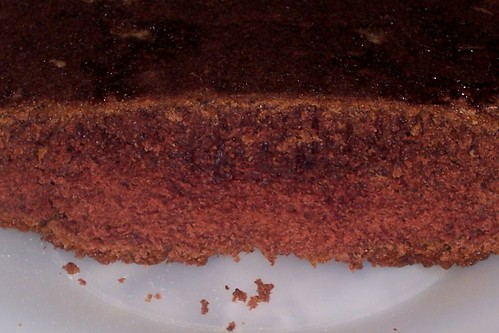For whatever reason -- I do not know and can't explain -- the mood was specifically for red velvet cake.
The problem with red velvet cake is that most recipes call for something like 2 fluid ounces of red food colouring -- about a quarter cup. That's a lot. Leaving aside, for the moment, the issue of whether or not artificial food dyes are bad for you, I don't like cooking with them. They have a taste of their own and I don't care for it.
If you've ever stopped at a convenience store for a slushy drink, you probably know the taste I mean. The cherry/strawberry/etc slushies all taste about the same, and the flavour is 'red.' I suspect that when people tell you red velvet cakes are tangy, it's the red they're tasting.
So I did a little research into substitutes for the red. Beet juice would seem like an obvious substitute, but the beet-tinted cake recipes I read about all seemed to end up brown.
Then I came across a few assertions that the food dye was really an afterthought, that the chemical reaction that occurs between the cocoa powder, the buttermilk, and the vinegar in the recipe produces a red (or reddish) cake, and that the artificial red was added after Dutch process cocoa powder became widespread. Dutch process cocoa is more alkaline than regular cocoa and therefore messes up the chemistry that gives you a red cake.
Oh really? thought I. Well, let's try it.
Most of the red velvet cake recipes you will find are about the same; I used a mash-up of a couple:
1 cup butter
1 1/2 cup sugar
2 eggs
1 tsp vanilla
1 Tbs vinegar (cider vinegar is fine)
1 cup buttermilk
1 tsp baking soda
2 1/3 cup cake flour
2 Tbs cocoa (not Dutch process)
1 tsp salt
Cream the butter and sugar together. Beat in eggs, then add vanilla and vinegar.
Sift together the dry ingredients. Add them alternately with the buttermilk to the butter mixture and stir until thoroughly combined. Pour batter into two prepared layer cake pans and bake at 350 for 25-30 minutes.
The batter was beige. Not promising.
The cake that came out of the oven also looked anything but red. I set it on the cooling rack and considered whether I should describe it as a 'brown velvet cake' or just a 'velvet cake.'
I was not in the mood to mess around with layers and icing, so I just cut the cake into squares. Lo and behold:

the crumb was actually kind of red. Not the bright scarlet you'd get with 2 fluid ounces of red colouring added, but definitely not beige.
Now, the added twist (because I must always have an added twist): does using cultured buttermilk (the kind you can buy at the grocery store) versus using churn buttermilk (the stuff left over from making butter) make a difference?
According to the U.S. Food and Drug Administration's Center for Food Safety and Applied Nutrition, the pH of buttermilk ranges from 4.41 - 4.83. Presumably that's for cultured buttermilk. I can't find anything that discusses the difference (if any) between the pH of cultured and churn buttermilk.
Because I am the sort of person who likes any excuse to use her stand mixer, I actually made butter this past week. A pint of heavy cream makes about 8 ounces of butter and slightly over a cup of buttermilk, so I used that homemade buttermilk to make the cake, and I am in no position to make an accurate test of the pH of my homemade buttermilk. I should probably try this again with cultured buttermilk and see if that makes a difference in the colour.
And the cake? Nice cake. The texture is the real star of the show, and probably why it's called a velvet cake. The flavour is quite mild. I did not detect any of the tang that people say they taste (again, I wonder if what they're tasting isn't 'red'). Red velvet cakes aren't really chocolate cakes, though sometimes they're described as such. Two tablespoons of cocoa powder does not make a chocolate cake. There is a chocolate note in the cake, but the cocoa is there for the colour, not to give intense chocolate flavour, so if you're looking for a seriously chocolatey cake, this is not the recipe you want. If you want a cake to deliver a good icing, this is your cake. The Viking pronounces it to be a good snacking cake as well.


This article was sooooo fantastic. Thank you so much for the tips it was exactly what I was looking for...
ReplyDeleteMaybe this would be nice with a Oaxican flair to it. Using Mexican Chocolate and a pinch of spice (Mexican Cinnamon and/or Cayenne) for the zip you wanted. Could be terrible but it could be awesome! Maybe this weekend...
Mmm, the Mexican chocolate route could be tasty. Maybe with a touch of cinnamon/cayenne in the frosting? Thanks for the great idea!
ReplyDeleteSo, I'm curious whether you ever attempted a dye free red velvet cake again with any alterations.
ReplyDeleteI'm looking for an amazing red velvet cake recipe & suspect that the dye not only detracts from the cake, but that other parts of the recipe have changed because of the dye as well.
Thanks for this post. I think I'm just beginning a quest to create the perfect dyeless red velvet cake & you've given me a great starting point.
Hi Matthew,
ReplyDeleteNo, I haven't really done much more experimenting with red velvet cakes.
I do know that natural (as opposed to Dutched) cocoa has an effect on the leavening of the cake. It's the interplay of acids and bases again; you'll note that my recipe calls for baking soda (a base) but not baking powder, which is more usual in American cake recipes.
I look forward to seeing what you come up with!